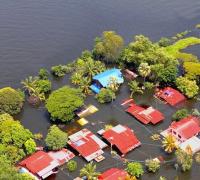COP21: Wins and losses for the Least Developed Countries
After a year in the shadow of terrorism, Paris shines bright again. The global climate deal reached on Saturday provided a much needed positive narrative for France and for the World. “Nous sommes Paris” now offers a different meaning.
But some are more Paris than others. Like all such deals, the COP21 Agreement was the result of a power struggle, and the US, China, India, EU and other big players made their mark. For the world’s poorest countries – the Least Developed Countries (LDCs) – the agreement could certainly have been better. But it wasn’t a failure. Here’s a run-down of the wins and losses on five issues that were key for the LDC negotiation group at COP21:
1. How binding is the agreement?
The LDCs are hit hard by climate change, and so wanted an agreement that was as legally binding as possible in limiting emissions from the major economic powers. The final agreement is not binding when it comes to the individual national goals on which it is based. This is pretty much as expected, given the political situation in major powers such as the US. Instead, the agreement sets down a binding mechanism to regularly review and raise the ambition in national plans over time, and establishes transparency mechanisms so that climate laggards can be “named and shamed”. The strategy behind this approach, which gained ground after the failed COP15 in Copenhagen, is based on the idea that the only way to solve super-complex negotiation situations is through gradual incremental change, where stakeholders are nudged in the right direction, step by step. This is a risky approach, but perhaps the most realistic one. The LDCs seems to have accepted its inevitability. Giza Martin, Chair of the LDC group, put it like this: “It's not the perfect deal, but it's the best deal”.
2. The 1.5 degrees
Another main goal for LDCs during the negotiations was to set the maximum global temperature increase at 1.5 °C above pre-industrial levels. Few observers gave it much chance beforehand, but during the Paris negotiations it gradually gained support. The final agreement now aims to keep the temperature rise “well below” 2 °C, while “pursuing efforts” to keep them within 1.5 °C. The wording is vague and many climate scientists consider it unrealistic. It could also be seen as a fairly manageable trade-off for the big emitters, with convenient publicity effects. But symbolically, it was an important victory for the countries that have largely been marginalized in previous negotiations: In the public narratives of the conference, the fact that the 1.5 °C aim made it to the final agreement is generally credited to a persistent push by the most climate vulnerable countries, including small island states and African and Asian LDCs.
3. Financing for adaptation
"Finance is the bedrock of disagreement" said Gambia’s Minister of Environment, Pa Ousman Jarju, during an LDC press conference before the deal was made. For the LDCs, financing for adaptation to climate change is particularly important, but has long been the poor relation in the climate finance game. The LDCs gained modest ground here: Adaptation now features more strongly in the agreement than previously, and the main funds of importance to LDCs saw some replenishment (including the Least Developed Countries Fund, the Adaptation Fund and the all-important Green Climate Fund). However, the LDCs and the wider G77 group failed to pressure the developed countries significantly on the longer term aspects of global climate financing. Some of the USD 100 billion annually that developed countries pledged in Copenhagen in 2009 have already been committed and are being disbursed – although exactly how much became hotly contested during the talks. Developing countries failed to get a clear statement in the agreement that these funds should be new and additional to existing ODA. A proposal to discuss scaling up the funds above the USD 100 billion was adopted, but not until “prior to 2025” which is a good deal later than the LDCs had hoped for.
4. Loss and Damage
This term covers losses that have already been incurred from climate change, such as displacement and loss of land and agricultural production as a result of rising sea levels, floods and droughts. Together with the small island states group, LDCs have been significant drivers in bringing the Loss and Damage topic to the table in the climate negotiations, seeking a mechanism whereby such losses could be directly compensated by high emitters. In past COPs, the notion has been hotly contested by the US and other developed countries, who cringe at the implications of a direct compensation and liability scheme. In the Paris agreement, the principle of Loss and Damage is not only included but also fairly well described and consolidates a previously established body on the topic (the so-called Warzaw mechanism). Given the disputed nature of the topic, this is in itself a small victory for LDCs and other vulnerable countries. However, the party stops there: The agreement also clearly states that Loss and Damage “does not involve or provide a basis for any liability or compensation”. This lets the developed countries off the hook, and shifts Loss and Damage towards a more traditional pledge-based system.
5. Recognition of LDC’s special needs
Finally, the LDCs argued for special consideration of their particularly difficult circumstances, ie being highly threatened by a climate situation they have not contributed to, and having limited resources to confront the problem. This demand is quite well reflected in the Paris agreement: It specifically provides a lower reporting burden for LDCs on climate strategies, plans and actions, and mentions that the proposed transparency framework must “recognize” their situation – a caveat one hopes will not be unduly exploited. The agreement also urges developed countries to pay particular attention to LDCs when funding capacity development and technology transfers. The latter is a sometimes overlooked interest of the LDCs. While not being naïve, LDCs increasingly see an opportunity to build their emerging energy systems with renewables.
For LDCs, then, the Paris Agreement wasn’t a perfect deal, but acceptable under the circumstances. The ever present issue of financing remains tenuous, although pledges by the US, EU and other developed countries to support LDCs with dedicated funds made the pill easier to swallow. From a cynical viewpoint, these contributions may have been fueled further by the concerns among Western powers over destabilization and migration across the Sahel and Horn of Africa, where many LDCs are located. Nevertheless, it would be wrong to view the gains for LDCs in the Paris agreement as purely orchestrated by the major powers. The timing was right, and the insistence and strategic maneuvering of LDCs and other vulnerable countries clearly played a role in securing the gains that they did, after all, achieve.
DIIS Experts


